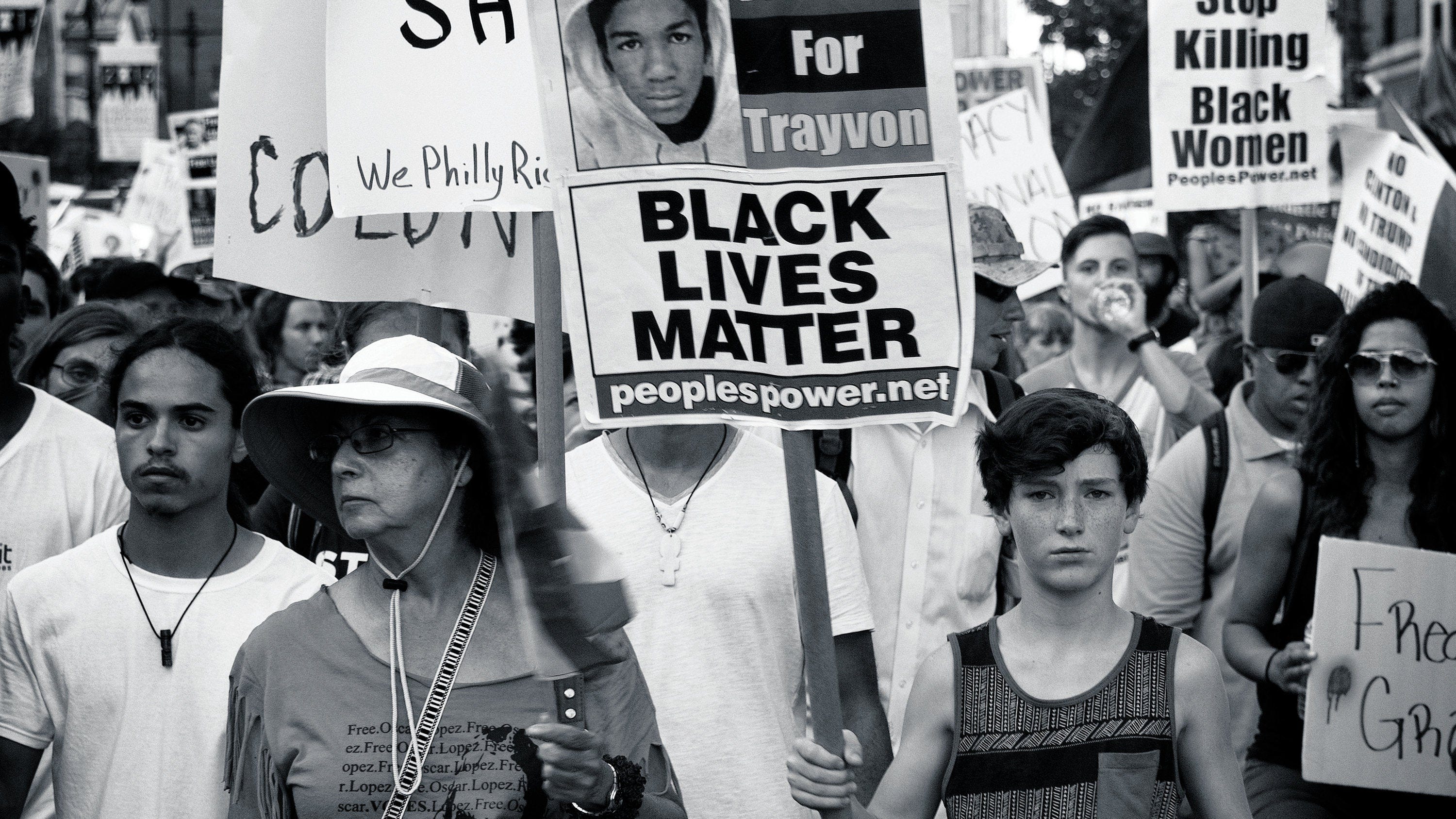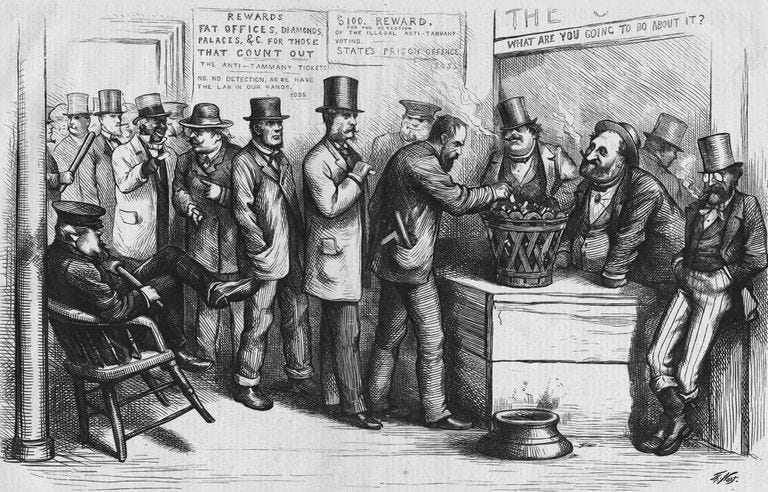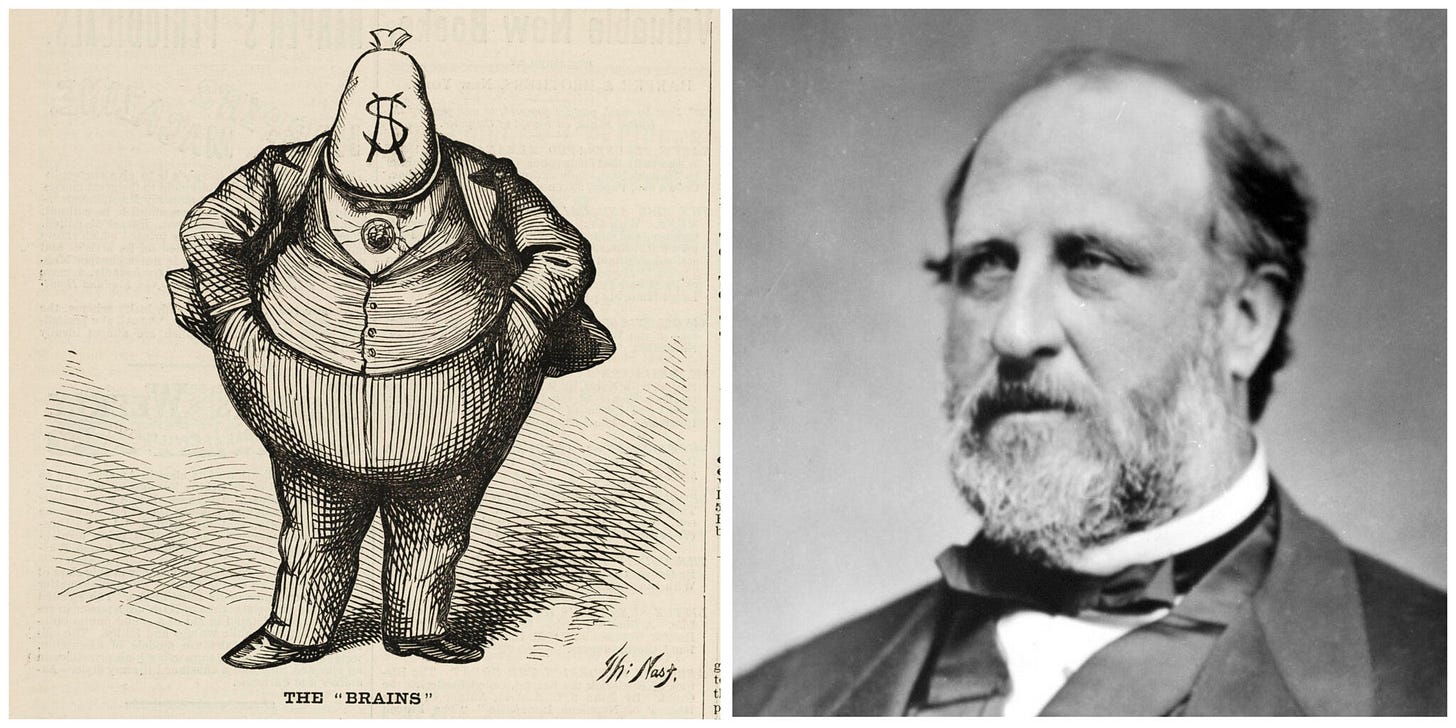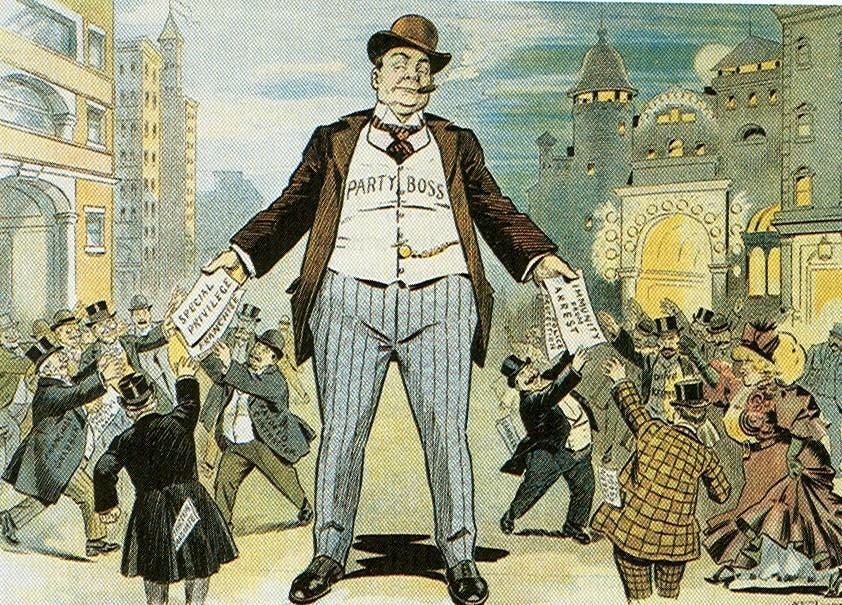DEI is political patronage for the Democratic party
that replaces the older patronage of urban party machines.
Make someone’s day: Gift a subscription to your friends and family!
This article is part of a multi-part series on Diversity, Equity, and Inclusion (DEI):
From the 1830s until about the 1970s, American urban politics was dominated by the urban machines of the Democratic party. These machines dominated city politics in the Northeast and Midwest for well over a century.
The most famous was Tammany Hall, which essentially ran New York City politics for over a century. Tammany Hall served as a template for urban Democratic machines throughout the nation.
To be fair, Republicans also had their urban machines, but they were rarely as large or as effective as Democratic urban machines. Republican parties essentially copied Democratic urban machines as a means of political survival. In general, Republicans relied on Protestant rural and small-town voters who are much harder to organize into machines because of their dispersed populations.
The power of Democratic urban machines was based on the following:
Federalism, which gave a significant amount of power to local and state governments.
Single-member electoral districts, which made it possible for one party to dominate a specific geographical area for decades.
Party nomination by closed caucuses. Essentially, the local party leaders chose their party nominees in “smoke-filled rooms.”
The extraordinary talent of Irish politicians. No ethnic minority has played anywhere near as important a role in politics as the Irish Catholics. They particularly excelled at personal charisma and local political organization.
A very limited American welfare state until 1932, which gave an opportunity to machine politicians to provide tangible benefits to potential voters, particularly new immigrants from Catholics.
Virtually no professional civil service and a patronage system (often called the “spoils system”) that enabled elected officials to disperse tax revenue, jobs, and political favors to their supporters.
Systematic ballot fraud (which kept the entire process functioning smoothly and ensured a steady flow of money)
Massive waves of immigrants from the 1840s to 1914, which gave “fresh meat” for the political machines. Many immigrants did not speak English and were desperately poor even by the standards of the day. They were grateful to accept assistance from any institution, regardless of the legality of that assistance.
All of the factors listed above were important to the dominance of Democratic urban machines, but patronage and ballot fraud were how they functioned. The urban machines essentially focused on the following strategy:
You and your people vote for us, and we will distribute tax revenue, jobs, and political favors back to you.
And the term “your people” was typically defined as your ethnic or religious group. In the 19th and early 20th Century, a vast number of ethnic and religious minorities were scattered across the nation. These minorities were heavily concentrated geographically, so typically one ethno-religious group had the majority in any one locality or neighborhood.
Where no ethno-religious group possessed the majority, minority groups typically banded together to form local governing coalitions (typically via the Democratic party). This was most often the case in large industrial cities of the Northeast and Midwest.
In a period where there were few major political issues and people were focused on survival, this was a pretty beneficial exchange, particularly for fresh immigrants.
Decline of the Urban Machines
Since about the 1970s, traditional Democratic urban machines have declined from their once dominant role because of the following factors. Each of these factors seriously undermined the ability of traditional Democratic urban machines to distribute jobs to their supporters:
The increasing dominance of college-educated voters within the leadership of the Democratic party. This has pushed the party to the Left on a series of cultural issues where traditional working-class voters are moderate or conservative: foreign policy, military spending, war, environment, religion, immigration, climate change, abortion, race, gender, sexuality, family structure, etc.
The above list of issues makes many working-class voters perceive themselves as not being represented by the Democratic party.
Civil service reform that undermined the patronage system.
Party caucuses being replaced by primaries open to all Democratic voters. This meant that urban political machines could no longer choose candidates for their party.
The resulting rise of individual politicians who no longer feel tied to the party.
Irish Catholics and other working-class voters integrating into American society and experiencing upward mobility.
Post-World War II suburbanization, which moved voters beyond the reach of political machines in the central city.
The Immigration Act of 1924 almost completely cut off immigration until the 1970s.
The advent of new communication and political organizing technologies that undercut the power of urban machines (many of which were pioneered by Republicans who were fighting back against Democratic urban machines):
Television, particularly free television news and campaign ads
Direct mail, which enabled target outreach to individual voters regardless of their location.
Financial donations that bypass party leaders
Internet
Social media
The massive increase in spending for political campaigns.
Rise of Independent and ticket-splitting voters who are more loyal to individual candidates or policy preferences rather than partisan loyalty.
From the 1980s until about 2010, Americans lived with a “candidate-centered” political system where urban machines could simply not compete. Indeed, by 2010 it looked as if urban machines were as extinct as dinosaurs.
Affirmative action and DEI stepped in to fill the gap
It should not be a surprise that just about when the power of urban machines declined and government social programs grew in size, an alternative for traditional political patronage was invented. That alternative was first affirmative action, which then later evolved into Diversity, Equity, and Inclusion (or DEI).
Supporters of affirmative action and DEI claim that they are primarily motivated by a fight for Social Justice, but they are very selective in which groups that they are most concerned about. Any deviation from equality of outcomes that underrepresents their favored groups is treated as a gross violation of morality, but when other groups are under-represented they say barely a word. More revealing, they get very angry when anyone else presents the evidence.
Now, to be clear, I am not saying that Democratic operatives invented those policies as a means of paying off voting constituencies. The supporters of affirmative action and then DEI truly believed (and still do) that those policies are about fighting for Social Justice.
But whenever ideological motivation is tied to material interests, flowery rhetoric will be used to cover up the underlying material interests.
Ask yourself: Is it really a coincidence that:
As evidence of real racial and gender discrimination declines, the definition of “discrimination” is just broadened to make it seem as those discrimination is widespread?
Every demographic group that benefits directly from affirmative action and DEI just happens to be strong supporters of the Democratic party (except perhaps Jews and Asian-Americans)?
DEI activists are not the slightest bit concerned about dramatic Black over-representation in sports and entertainment? By their own logic, this must be due to discrimination against Whites, Hispanics, and Asians, but somehow this is not a concern of theirs.
DEI activists are not the slightest bit concerned about dramatic female over-representation in education and other fields? By their own logic, this must be due to discrimination against men.
DEI activists are not the slightest bit concerned about men being over-represented in prison and the homeless population? By their own logic, this must be due to discrimination against men.
DEI activists are not the slightest bit concerned about under-representation among white ethnic groups or religious minorities? By their own logic, this must be due to ethnic or religious discrimination.
DEI activists ignore (and try to shut down discussion of) non-white ethnic groups who have been extremely successful as immigrants? Can they even explain why so many non-white groups voluntarily want to immigrate to a nation that is supposedly permeated with systemic racism?
The only logical argument that can answer those questions is that affirmative action and DEI are not solely about fighting discrimination or for Social Justice. Affirmative action and DEI also serve another purpose. Affirmative action and DEI are also alternate forms of political patronage to replace the demise of the traditional urban machines.
DEI hiring, firing, and promotion practices have become commonplace within:
the Federal government
State governments
Local governments
Contractors of all of the above
K-12 public education
Private and public universities
Most large corporations
Most large non-profits
All of the above enables the modern Democratic party to distribute jobs and money to its supporters at a far larger scale than any of the older urban political machines were able to do. And they can morally legitimize the practice by saying that it is for Equality and Social Justice.
Mandating DEI hiring, firing, and promotion practices and enforcing those practices selectively enables the Democratic party to funnel jobs and taxpayer money to party supporters, particularly blacks and women. For some reason, Republicans have looked the other way for over 50 years. Trump appears to be the only Republican who understands how critical DEI is to supporting the infrastructure of the Democratic party and is seeking to dismantle it.
Now if this were the only negative impact of DEI, then the practice might seem innocuous. Unfortunately, the policy and practice of DEI have many other negative consequences for society, including:
Undermining the moral legitimacy of merit-based hiring, firing, and promotions.
Sabotaging the competence and legitimacy of our institutions.
See also my other articles and podcasts on Ideology:
Why Ideologies Threaten Progress (Part 1 of 3-part podcast series)
Why ideologies fail (podcast)
Descent into a man-made Hell: Understanding modern Totalitarianism
You might also be interested in reading my “From Poverty to Progress” book series:










Since I grew up in the Chicago of Mayor Daley the first, I can claim some acquaintance with traditional party machines. I think this article is a laundry list, where you have every possible factor that anyone's ever thought of. If everything is important, then nothing's important.
Particularly, the section "Decline of the Urban Machines" has (1) no differentiation on which factors mattered the most, and (2) factors don't apply particularly to Chicago. I can't speak for NYC.
The move to suburbia happened after WW II and had no effect on the Chicago machine. Both Daleys ruled long after that, as did Rahm Emmanuel. Civil Service reform happened in the 1800's. Primaries existed long before the Machine fell apart. Television and debates had no impact. The 1924 immigration reforms had no effect. Ethnic neighborhoods lived on in Chicago for at least 50 years after that. I grew up in a multi-ethnic one (Irish, Polish, Italian, etc.)
In the old days, having a job with the City meant you were a precinct captain or ward committeeman, and keeping the job meant delivering the Democratic votes in your area. Once people were able to get good jobs without bowing to the Machine, and follow politics on their own, then it started to fall apart. A general atomizing of society also helped in that.
I'm not a supporter of DEI but it did not rise as an alternative source of patronage. Analyses of political movements in the last 15 years and where "wokeness" came from have been coming thick and fast since the election and those are a better explanation.
Great article, although I would take issue with the assertion that Asian-Americans and Jews benefit much if at all from DEI. Asians and Jews appear to be Schrodinger’s minorities, oppressed minorities when convenient for the left, white-adjacent when not. But on balance Asians and Jews do great in the U.S. without the need for DEI, and in reality both groups would be wildly overrepresented on elite university campuses (which frequently lead to elite jobs) if DEI admissions criteria were discarded.